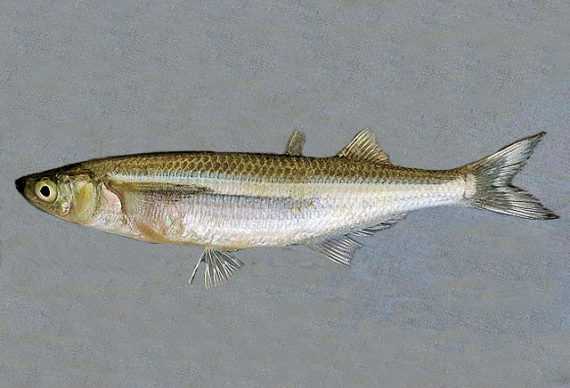Silversides: Family Atherinidae
Species: Atherinops affinis (Ayres, 1860); from the Greek words ather (a spike or arrow) and ops (like), and the Latin affinis (related to an associated species).
Alternate Names: Smelt, bay smelt, rainbow smelt, least smelt, little smelt, silverside, capron, pescadillo, Panzarotto. Called pejerrey mocho or pejerrey pescadillo in Mexico.
Identification: Typical smelt shape with large scales and a small first dorsal fin. Color is bluish-gray above, bright silver below. A narrow bright silver band edged with bright blue or purple extends the length of the body. The cheek has a yellowish blotch. It differs from the jacksmelt in that the origin of the anal fin is under the insertion of the first dorsal fin and it has forked jaw teeth instead of conical teeth.
Size: To 15.3 inches. Most caught from piers are under 10 inches long.
Range: Bahia Magdelena, southern Baja California, and the Gulf of California, to Agate Beach, west of Sooke Harbour, Vancouver Island, British Columbia. Common from Bahia Magdelena, Baja California, to northern Oregon.
Habitat: Bays and nearshore, shallow oceanfront areas. Often found in mixed schools with jacksmelt. Found from the surface down to an 85 foot depth.
Piers: Caught at almost all California piers. Best bets: Ocean Beach Pier, Oceanside Pier, Balboa Pier, Newport Pier, Hermosa Beach Pier, Manhattan Beach Pier, Goleta Pier, Pismo Beach Pier, Morro Bay T-Piers, Monterey Wharf #2, Santa Cruz Wharf, Fort Point Pier, San Francisco Municipal Pier, Berkeley Pier, Fort Baker Pier, Tides Wharf (Bodega Bay), Commercial Street Dock (Eureka), “B” Street Pier (Crescent City).
Shoreline: Sometimes taken by anglers fishing near rocks and jetties.
Boats: Frequently taken by boaters in Morro Bay and San Francisco Bay.
Bait and Tackle: Most commonly taken on snag lines in southern California; in northern California multi-hook leaders baited with small pieces of bait are used. Typically feeds in the top 10-15 feet of water so anglers should concentrate in this area for the fish.
Food Value: Given their size, fillets are typically small. The flesh is mild flavored and soft textured with moderate fat content. Typically pan-fried although there are a lot of bones and usually quite a few worms in the flesh. The worms are harmless after cooking but seem to prevent many from eating the jacksmelt.
Comments: Not as big as jacksmelt but taken in large numbers, especially in southern California.

Ocean beach pier 4 sure !